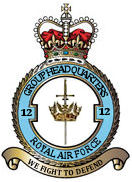No. 12 Group RAF
| No. 12 Group RAF | |
|---|---|

Group Crest
|
|
| Active | 1918–1919 1937–1963 |
| Country | United Kingdom |
| Branch | Royal Air Force |
| Type | Group Headquarters |
| Role | Defence of the Midlands and East Anglia |
| Part of | RAF Fighter Command |
| Garrison/HQ | RAF Watnall, Nottinghamshire, England |
| Royal Air Force Ensign |  |
No. 12 Group of the Royal Air Force was a command organization that existed over two separate periods, namely the end of World War I when it had a training function and from just prior to World War II until the early 1960s when it was tasked with an air defence role.
No. 12 Group was first formed in April 1918 at Cranwell, Lincolnshire, within No. 3 Area. It succeeded the Royal Navy's Central Depot and Training Establishment which had been training naval aviators at Cranwell since 1916. The first RAF General Officer Commanding was Brigadier-General H D Briggs who received the appointment on promotion from Captain in the Royal Navy. On 8 May 1918 the group transferred to Midland Area, and then to Northern Area on 18 October 1919. On 1 November that year the Group ceased to exist when it became the RAF (Cadet) College.
The group was reformed on 1 April 1937 in Fighter Command. It was the group responsible for aerial defence of the Midlands, Norfolk, Lincolnshire and North Wales. Construction of a purpose built site at RAF Watnall was not completed until late 1940, after which operations were relocated from nearby RAF Hucknall. During World War II this group was the second most important group of Fighter Command, and as such, it received its share of attacks from the German Luftwaffe throughout the war.
The commander of 12 Group during the Battle of Britain was Air Vice Marshal Trafford Leigh-Mallory, who was a rather ambitious man. Despite his length of service in the RAF, he was passed over for being named the Air Officer Commanding of the more vital 11 Group in favour of Air Vice Marshal Keith Park. Leigh-Mallory felt himself slighted over this and his relations with Park were poisoned thereafter.
...
Wikipedia
